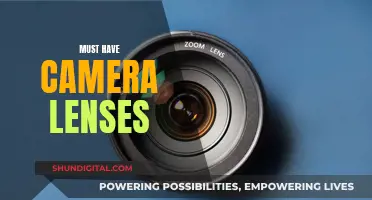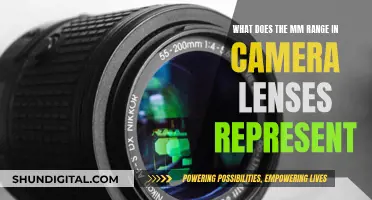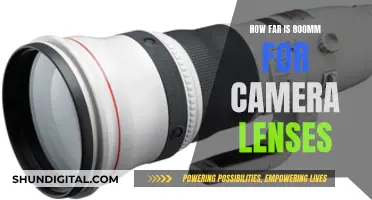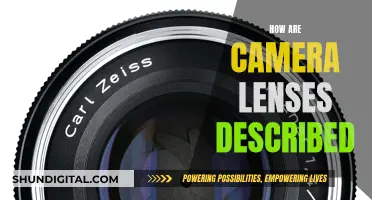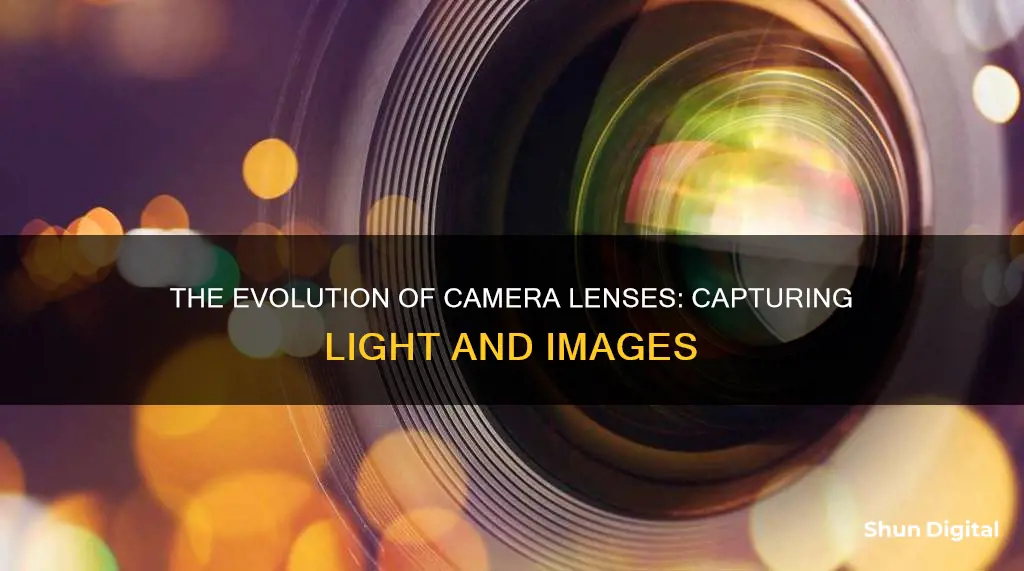
Cameras require lenses to capture images. The lens is the most important part of a camera as it focuses light onto the film or image sensor, forming an image. Without a lens, a camera is useless to a photographer as it would only be able to produce white light. Lenses are made of glass or other materials such as plastic, quartz glass, or fluorite, and they can be fixed or interchangeable. The focal length of a lens determines the magnification of the image, with shorter focal lengths providing a broader view and longer focal lengths capturing finer details of distant objects. The aperture of a lens, similar to the pupil of the human eye, controls the amount of light entering the camera, with larger apertures allowing more light in and shallower depths of field.
What You'll Learn

Lenses focus light to form an image
Lenses are an essential component of any camera. They are what allow the camera to focus light from the viewfinder into a tiny spot, usually 35mm, on the back of the camera, thus forming an image. Without a lens, a camera is useless to a photographer as the only image it can produce is white light.
The lens is made of glass, which is important to its function. Glass has good optical properties and is resistant to scratching. The front element of the lens is critical to the performance of the whole assembly. Its surface is coated to reduce abrasion, flare, and surface reflectance, and to adjust the colour balance.
The focal length of a lens governs the amount of a scene that is photographed. On a 35mm camera, a normal 50mm lens has a similar view to the human eye. Lenses with shorter focal lengths (under 35mm) are called wide-angle lenses and give a broader view of the scene. Lenses with much longer focal lengths are called telephoto lenses and are used to show detail in distant objects.
The brightness of the light reaching the film or image sensor is controlled by a hole called the aperture. It works like the pupil of the eye, getting larger in the dark to let in more light and smaller in bright conditions. The aperture size is controlled by the lens using a diaphragm (a mechanical iris).
The lens also determines the depth of field, or how much of the scene in front of the camera appears in focus. Lenses with very narrow openings have a very deep depth of field, while lenses with very wide openings have a shallow depth of field.
Understanding Camera Lenses: Capturing Unique Perspectives
You may want to see also

The lens' focal length determines magnification
Cameras have lenses to focus light from the viewfinder into a tiny spot, usually 35mm, on the back of the camera. The lens is what allows a camera to produce an image, rather than just white light.
The Lens Focal Length Determines Magnification
The lens focal length determines the magnification of the image projected onto the image plane. In most photography and all telescopy, where the subject is essentially infinitely far away, a longer focal length (lower optical power) leads to higher magnification and a narrower field of view. Conversely, a shorter focal length or higher optical power is associated with lower magnification and a wider field of view.
The focal length of an optical system is a measure of how strongly the system converges or diverges light. A positive focal length indicates that a system converges light, while a negative focal length indicates that the system diverges light. A system with a shorter focal length bends the rays more sharply, bringing them to a focus in a shorter distance or diverging them more quickly.
The effective focal length (EFL) is the inverse of the optical power of an optical system and is used to calculate the magnification of the system. The EFL can be thought of as a thin lens with the same properties as the optical system.
In telescopes, the objective lens projects an image onto its focal point, which then acts as the object for the eyepiece. The eyepiece magnifies the image, and a smaller focal length will result in higher magnification.
A longer focal length will result in a larger virtual image, and when the eyepiece magnifies this image, it will appear even bigger.
The Ultimate Lens Guide for RED Camera Systems
You may want to see also

Aperture controls the amount of light entering the lens
A camera lens is an optical lens or assembly of lenses used in conjunction with a camera body to make images of objects on photographic film or other media capable of storing an image chemically or electronically. The lens is what focuses light from what you see through the viewfinder into a tiny, typically 35mm spot on the back of your film, DSLR, or mirrorless camera. If you remove the lens from your camera, the only kind of image you can produce is white light.
The aperture of a lens is the opening through which light passes into the camera. The wider the opening, the more light can reach the camera sensor, which in turn affects the exposure of the image. Just as the pupil in the human eye contracts in bright conditions and expands in low-light environments, the aperture needs to decrease or increase to achieve correct exposure – that is, a clear image that's not too dark or too washed-out – in different lighting conditions. This is done by an array of aperture blades in the lens that move synchronously to adjust the size of the aperture, up to the maximum that the lens is mechanically capable of attaining.
The aperture stop generally depends on the object point location. On-axis object points at different object planes may have different aperture stops, and even object points at different lateral locations at the same object plane may have different aperture stops. In practice, many object systems are designed to have a single aperture stop at a designed working distance and field of view.
The aperture of a lens quite simply controls the amount of light entering the lens. The wider the opening, the more light can reach the camera sensor, which in turn affects the exposure of the image.
Choosing the Right Camera Lenses for an Alaskan Cruise
You may want to see also

Lenses can be interchanged for different effects
Interchangeable lenses can be used for different purposes, camera types, and camera models. For example, a full-frame camera requires a full-frame lens, and macro photography requires a dedicated macro lens. Different lenses also have different focal lengths and optical characteristics, which can be used to create different effects. A telephoto lens, for instance, can help capture sharp photographs of objects that are far away, while a wide-angle lens is more suitable for landscape and cityscape photography as it has a wider field of view.
The type of lens mount also affects the compatibility of the lens with the camera body. Different camera brands often use different types of mounts, so it is important to ensure that the lens is compatible with the camera's mount. Adapters can be used to connect different types of mounts, but these can sometimes limit lens functions, such as autofocus or requiring manual adjustments.
Interchangeable lenses can also vary in terms of being prime lenses or zoom lenses. Prime lenses have a fixed focal length and are often optically superior to zoom lenses, offering better image quality and more light. Zoom lenses, on the other hand, offer more flexibility in composing an image without having to change position.
In summary, interchangeable lenses offer photographers a wide range of creative possibilities, allowing them to capture different types of images and achieve different effects by swapping out lenses with different characteristics, focal lengths, and mounts.
Cleaning Your SLR Camera Lens: A Step-by-Step Guide
You may want to see also

Lens coatings can improve image quality
Cameras are equipped with lenses to focus light from the viewfinder into a tiny spot, typically 35mm, on the back of the camera. The lens is what allows the camera to capture images.
Lens coatings work by adding a thin layer of material with a lower refractive index than glass, reducing the amount of light reflected and increasing the amount of light transmitted. The first lens coating was discovered by English mathematician and scientist Lord Rayleigh in 1886, who found that old tarnished glass transmits more light than new untarnished glass due to the two successive interfaces of air/tarnish and tarnish/glass. In 1935, Zeiss engineer Alexander Smakula patented the first coating using multiple layers of chemicals, dramatically improving the performance of lens coatings.
Today, most lenses are multi-coated to minimize lens flare and other unwanted effects. Lens coatings can improve light transmission from about 96% to above 99.7%, which is especially beneficial for low-light photography. They also help to control color rendition and reduce flare and ghosts, which are caused by a large amount of reflected light from the lens surface and inside the lens.
In addition to improving image quality, lens coatings also have the added benefit of reducing abrasion, flare, and surface reflectance, as well as adjusting the color balance.
The Science Behind Purple Camera Lenses
You may want to see also
Frequently asked questions
The lens is the most important part of a camera. It focuses light onto the film to form an image, and unless that image is sharp, the pictures will not be clear.
Lenses take light rays entering them and force them to converge at a single point. The image sensor in a camera is a single flat plane, so only light sources from a single plane are ever in focus.
The focal length of a lens is the distance between the lens and the film when the lens is focused at infinity. The shorter the focal length, the broader the view of the scene.
Prime lenses have a fixed focal length, whereas zoom lenses have the ability to zoom in and out. Prime lenses are usually sharper and produce less distortion than zoom lenses, but they can be more expensive and less versatile.


